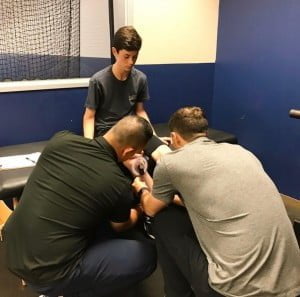Introduction
I first learned to look at body structure after hearing the phrase, “Structure dictates function”. In 2010, Eric Cressey said this in his shoulder series called “Optimal Shoulder Performance”. https://ericcressey.com/optimal-shoulder-performance-now-available.
Hearing this phrase instantly changed how I went about looking at the body structure in all of our athletes. In a nutshell, this means the function of the body is dictated by how the body is structured. From that time forward I stopped looking at movement as a series of isolated movements. I now look at overall movement as a series of interrelated links that build off one another.
Where It Started
When I first started to look at the pitching and hitting motion, I used to look at certain aspects of players movement. I never took into consideration how specific movements influenced other movements later in the delivery. I was more focused on achieving the way the move “looked”. Instead, I should have been focusing on what that particular movement was actually doing for the entire swing or throw.
Baseball Application
For example, loading the hands mid-swing or positively disconnecting the glove side in pitching were examples of the most important mechanical checkpoints. I originally thought if someone could pass through these positions, it increased our chances for success. Ultimately, I should have been more concerned with certain actions and how it affects the rest of the body. This approach is different from my previous approach.
Every single movement throughout a baseball player’s mechanical sequence is highly dictated by the previous movements in the chain. The kinetic chain was described by Franz Reuleaux in 1875 as a system. More on Reuleaux can be found here: https://en.wikipedia.org/wiki/Franz_Reuleaux. Furthermore, he states that movement at one joint produced or affected movement at another joint in the kinetic link. Movement and mechanics are highly dependent on the reactions and movements of previous segments of the body.
In order for the body to properly execute a movement we need to first understand a body’s particular structure. Assessing our athletes from head to toe is extremely crucial for their development. This allows us to get a full understanding of how their body is structured.Pictured here is us checking on one of our athlete’s hip internal rotation.

It Is very common for coaches and parents to look at big leaguers like Aroldis Chapman, Mike Trout, etc. and relay to the player that they should be moving this way. This is a very inaccurate way to go about “fixing” specific movement patterns in the body. We need to dig deeper and first understand how each player is put together structurally. Above all, body structure and coordination all play a major role in an athlete’s ability to move correctly.
A Mechanical Perspective
Let’s take a look at a pitcher’s glove side and why it’s important to make sure this is working the right way. Positive disconnection of a pitcher’s glove side helps drive rotation of the torso. It requires a lot of mobility and coordination from the upper back and the scapula. The scapula needs to go through protraction (away from the midline), retraction (toward the midline), depression (downward) and elevation (upward). If the scapula does not have the mobility necessary to execute this motion, this can negatively affect the rest of the throw. Insufficient mobility will cause the scapula to reach the end range of motion much sooner. This leads to less power generation and earlier ball release. Both of these things end up hurting pitch maximization. In addition to increasing the likelihood of injury.
Mechanical Analysis
Having the ability to move through a full range of motion plays a major role in power production and preventing injury. Having necessary range of motion in the joints that are being used is crucial for power production. Full range of motion across joint structures allows for proper speed accumulation to take place. Explosive movement takes very little time to complete, however the space to create the movement is still extremely important. Trying to create fast and explosive movements without the time to complete the reaction does two different things:
- It slows down proper speed summation.
- It makes surrounding joint structures prone to injury when trying to slow down.
Ultimately, incorrect movements leads to injury when tissue loading exceeds tissue tolerance. Not having enough runway to allow the structures to slow down properly will eventually cause the brakes to blow out. Therefore, soft tissue injury is common when this happens. Below shows positive disconnection of the glove side in a particular pitching drill.
Courtesy of: Driveline Baseball
In Closing
In this day and age, baseball athletes are getting bigger, faster, and stronger. This is why it’s even more important that we get a full understanding of what they can and cannot do before suggesting certain mechanics or training protocols. Oftentimes as coaches we are so eager to help our athletes that we can sometimes blow over the full body assessment. In the end this is the most important part of the training process. Gaining an understanding of what is a mechanical problem vs. a function of their anatomy will save loads of time to help that athlete reach their goals. In the end, it is always our responsibility as coaches to provide the most accurate information to further better them as baseball players.
Sources:
“Kinetic Chain .” Physiopedia.com. N.p., 3 Jan. 2020. Web. 7 Apr. 2020.
Davies , Dr. Craig , and Dr. Vince DiSaia . Golf Anatomy . Champaign, IL : Human Kinetics , 2019. Print.

